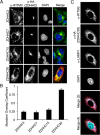The palmitoyltransferase ZDHHC20 enhances interferon-induced transmembrane protein 3 (IFITM3) palmitoylation and antiviral activity
- PMID: 29079573
- PMCID: PMC5766958
- DOI: 10.1074/jbc.M117.800482
The palmitoyltransferase ZDHHC20 enhances interferon-induced transmembrane protein 3 (IFITM3) palmitoylation and antiviral activity
Abstract
Interferon-induced transmembrane protein 3 (IFITM3) is a cellular endosome- and lysosome-localized protein that restricts numerous virus infections. IFITM3 is activated by palmitoylation, a lipid posttranslational modification. Palmitoylation of proteins is primarily mediated by zinc finger DHHC domain-containing palmitoyltransferases (ZDHHCs), but which members of this enzyme family can modify IFITM3 is not known. Here, we screened a library of human cell lines individually lacking ZDHHCs 1-24 and found that IFITM3 palmitoylation and its inhibition of influenza virus infection remained strong in the absence of any single ZDHHC, suggesting functional redundancy of these enzymes in the IFITM3-mediated antiviral response. In an overexpression screen with 23 mammalian ZDHHCs, we unexpectedly observed that more than half of the ZDHHCs were capable of increasing IFITM3 palmitoylation with ZDHHCs 3, 7, 15, and 20 having the greatest effect. Among these four enzymes, ZDHHC20 uniquely increased IFITM3 antiviral activity when both proteins were overexpressed. ZDHHC20 colocalized extensively with IFITM3 at lysosomes unlike ZDHHCs 3, 7, and 15, which showed a defined perinuclear localization pattern, suggesting that the location at which IFITM3 is palmitoylated may influence its activity. Unlike knock-out of individual ZDHHCs, siRNA-mediated knockdown of both ZDHHC3 and ZDHHC7 in ZDHHC20 knock-out cells decreased endogenous IFITM3 palmitoylation. Overall, our results demonstrate that multiple ZDHHCs can palmitoylate IFITM3 to ensure a robust antiviral response and that ZDHHC20 may serve as a particularly useful tool for understanding and enhancing IFITM3 activity.
Keywords: DHHC; IFITM; IFITM3; ZDHHC; influenza virus; innate immunity; interferon; palmitoyltransferase; post-translational modification (PTM); protein palmitoylation.
© 2017 by The American Society for Biochemistry and Molecular Biology, Inc.
Conflict of interest statement
The authors declare that they have no conflicts of interest with the contents of this article
Figures






Similar articles
-
p53 promotes ZDHHC1-mediated IFITM3 palmitoylation to inhibit Japanese encephalitis virus replication.PLoS Pathog. 2020 Oct 27;16(10):e1009035. doi: 10.1371/journal.ppat.1009035. eCollection 2020 Oct. PLoS Pathog. 2020. Retraction in: PLoS Pathog. 2024 Nov 8;20(11):e1012698. doi: 10.1371/journal.ppat.1012698. PMID: 33108395 Free PMC article. Retracted.
-
Positive Regulation of the Antiviral Activity of Interferon-Induced Transmembrane Protein 3 by S-Palmitoylation.Front Immunol. 2022 Jun 13;13:919477. doi: 10.3389/fimmu.2022.919477. eCollection 2022. Front Immunol. 2022. PMID: 35769480 Free PMC article. Review.
-
Interferon-induced transmembrane protein 3 blocks fusion of sensitive but not resistant viruses by partitioning into virus-carrying endosomes.PLoS Pathog. 2019 Jan 14;15(1):e1007532. doi: 10.1371/journal.ppat.1007532. eCollection 2019 Jan. PLoS Pathog. 2019. PMID: 30640957 Free PMC article.
-
S-palmitoylation and ubiquitination differentially regulate interferon-induced transmembrane protein 3 (IFITM3)-mediated resistance to influenza virus.J Biol Chem. 2012 Jun 1;287(23):19631-41. doi: 10.1074/jbc.M112.362095. Epub 2012 Apr 17. J Biol Chem. 2012. PMID: 22511783 Free PMC article.
-
Regulation of the trafficking and antiviral activity of IFITM3 by post-translational modifications.Future Microbiol. 2014;9(10):1151-63. doi: 10.2217/fmb.14.65. Future Microbiol. 2014. PMID: 25405885 Free PMC article. Review.
Cited by
-
Interferon-induced transmembrane proteins inhibit cell fusion mediated by trophoblast syncytins.J Biol Chem. 2019 Dec 27;294(52):19844-19851. doi: 10.1074/jbc.AC119.010611. Epub 2019 Nov 17. J Biol Chem. 2019. PMID: 31735710 Free PMC article.
-
Insights into auto-S-fatty acylation: targets, druggability, and inhibitors.RSC Chem Biol. 2021 Aug 25;2(6):1567-1579. doi: 10.1039/d1cb00115a. eCollection 2021 Dec 2. RSC Chem Biol. 2021. PMID: 34977571 Free PMC article. Review.
-
Metallo-β-lactamase domain-containing protein 2 is S-palmitoylated and exhibits acyl-CoA hydrolase activity.J Biol Chem. 2021 Jan-Jun;296:100106. doi: 10.1074/jbc.RA120.015701. Epub 2020 Dec 3. J Biol Chem. 2021. PMID: 33219126 Free PMC article.
-
IFITM3 incorporation sensitizes influenza A virus to antibody-mediated neutralization.J Exp Med. 2021 Jun 7;218(6):e20200303. doi: 10.1084/jem.20200303. J Exp Med. 2021. PMID: 33882122 Free PMC article.
-
Site-Specific Lipidation Enhances IFITM3 Membrane Interactions and Antiviral Activity.ACS Chem Biol. 2021 May 21;16(5):844-856. doi: 10.1021/acschembio.1c00013. Epub 2021 Apr 22. ACS Chem Biol. 2021. PMID: 33887136 Free PMC article.
References
-
- Brass A. L., Huang I. C., Benita Y., John S. P., Krishnan M. N., Feeley E. M., Ryan B. J., Weyer J. L., van der Weyden L., Fikrig E., Adams D. J., Xavier R. J., Farzan M., and Elledge S. J. (2009) The IFITM proteins mediate cellular resistance to influenza A H1N1 virus, West Nile virus, and dengue virus. Cell 139, 1243–1254 - PMC - PubMed
Publication types
MeSH terms
Substances
Grants and funding
LinkOut - more resources
Full Text Sources
Other Literature Sources

